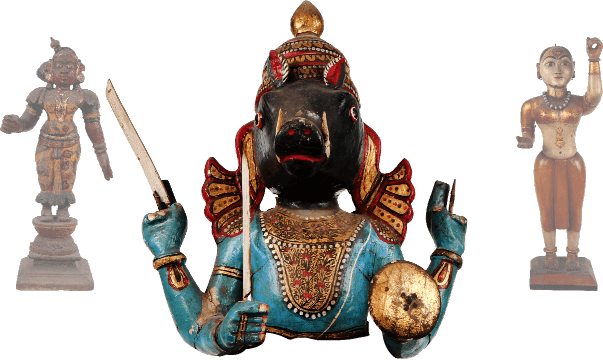Title : Painted Surahi
Accession No : 53/13/98
Painted terracotta Surahi without handle. The pot has a flat base and bulbous shaped body. The surahi is carved with geometrical and linear patterns around the neck of the body in concentric circle. It has an elongated neck and flared mouth.
Gallery
Provenance
- StateWest Bengal
Contributor
- Community / TribeKumhar
Dimensions
- Measurement (CMS)33 × 19.5 (dia)
Significance
- Socio economicTerracotta is clay-based ceramic pottery known for its expression of the human mind for ages. According to Hindu beliefs, this ancient form is considered auspicious for incorporating all the five classical elements of nature, namely, air, water, earth, fire, and space. Tracing back to its history, Terracotta models were found in abundance from the sites of Indus Valley Civilization like Birhana, Mehrgarh, Harappa, Mohenjodaro, etc. which dates backs to around 7000 BC. Slowly it was welcomed by Indian households in the form of kitchenware and other utility products, and gradually growing into homemade art and pottery. States like Gujarat, Rajasthan, and Madhya Pradesh still cherish their cultural heritage that propagates around Terracotta art, with distinctive crafts like hand-made jars, embroidered rooftops, and lanterns.
- Artistic"This is a traditional hand washing pot. It is also known as Surahi, Aftaba or Chillumchi. Aftaba is a water container, with a long handle and spout, used in Asian countries and usually made of metal. It is used to serve liquid i.e. water, coffee, tea or something to pour. It originates from the Great Mughal of Kashmir. Those were the old days, when craftsmen prepared antiques from pure gold and silver. This decorative element is beautifully carved. There are sketches of plants all around, beautifully embossed using ancient techniques. The handle is embossed with a beautiful elongated snake shape. Due to the minute work done as its this decorative element, it takes a long time to be prepared. The name Terracotta is derived from the Latin words ‘terra’ meaning ‘bake’ and ‘cotta’ stands for ‘earth’, which together translates to baked earth. These potteries are glazed or unglazed versions made from clay that has been dried and fired at 1000°C, resulting in distinct colors of orange, red, brown, yellow or gray. Once burned, it is cooled and brought to normal temperature by covering it in the sand. Therefore its color depends on both the type of clay used as well as the firing process."
Description
- DescriptionPainted terracotta Surahi without handle. The pot has a flat base and bulbous shaped body. The surahi is carved with geometrical and linear patterns around the neck of the body in concentric circle. It has an elongated neck and flared mouth.
- Inscription/Markings No
- Reference"Barnard, Nicholas. Arts and Crafts of India. London: Conran Octopus Limited, 1993 Ranjan, Aditi. Handmade in India: Crafts of India. Edited by Aditi Ranjan & M. P. Ranjan. Ahmedabad: Council of Handicraft Development Corporations, 2007."
- KeywordTerracotta, Surahi, Handle, Pot, Decorative

